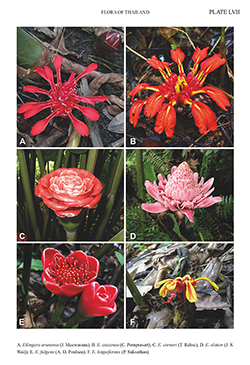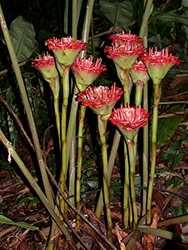e-Flora of Thailand
Volume 16 > Part 2 > Year 2023 > Page 481 > Zingiberaceae > Etlingera
3. Etlingera corneri Mood & Ibrahimwfo-0000415531
Nordic J. Bot. 20: 282. 2000; Khaw, Gard. Bull. Singapore 53: 216. 2001. Plate LVII: C.
Accepted Name : This is currently accepted.
Synonyms & Citations :
Description : Rhizome short-creeping, above leaf-litter or just below soil level, 3–4.5 cm diam., light green, tomentose, scales overlapping, green tinged dull to dark red; stilt roots 10–25 cm long, pinkish orange. Leafy shoots to 2.5–4(–6) m long, 6–14 cm between neighbouring leafy shoots, clump-forming, leafless in lower ⅓, with up to 22 leaves per shoot; base to ca 5 cm diam., tomentose; sheath longitudinally ribbed, with cross-bars, ± shortly puberulent; ligule to 10–20 mm long, shortly bilobed, emarginate with ca 7 mm incision, slightly asymmetrical, green, margin and surface densely covered with short hairs; petiole to 1.5–4 cm long, puberulent, base calloused; blade narrowly obovate, to 69 by 16 cm, length to width ratio 4.1–4.6, above prominently ribbed, dark green, lighter green beneath, glabrous, base cuneate to rounded, ± oblique; apex acuminate ca 1 cm; margin red, crisped, with short white or light brown hairs. Flowering shoot 0.7–1 m long, arising close to base of leafy shoot, receptacle 1–3 cm long, ovoid, with 50–80 flowers, 1–7 open at a time; peduncle erect above ground, 45–90 cm long, pubescent; peduncular bracts to ca 12, 2.5–13 cm long, shortest at base, enclosing, ± overlapping depending on length of peduncle, pale green at base, apex red, tomentose, apex ± bilobed with subapical mucro to ca 5 mm long, red; spike raised well above ground, 7–9 cm long (including flowers), flowers extending ca 0.5–1 cm above bracts; spike only including bracts cupuliform, firm, 7–9 by 7.7–11 cm; sterile bracts: 8–14 in 2–4 rings, tightly appressed, to 6–9 by 2–6 cm, oblong to slightly obovate, apex broadly obtuse to truncate, ± retuse, recurved downward ca 180°, with subapical mucro ca 5 mm long; outside green tinged red in upper half, inside bright red, white or pale green at base, all parts succulent, coriaceous, glabrous, sericeous at base; fertile bracts 3.5–7.5 by 0.5–4 cm, outer similar to sterile bracts, erect, spathulate, apex rounded to truncate, dark red, margin sometimes white, pubescent at base externally and lower ⅓ of margin; pedicel absent; bracteoles 3–3.8 cm long, white with red apex, strigose, apex unequally bilobed, lobes acute or rounded. Flower 5.3–6.3 cm long; ovary 4–6 by ca 4 mm, white, glabrous; style ca 3.6 cm long, white, hairy; stigma to 3 mm wide, triangular, sparsely hairy at apex, ostiole irregularly elliptic, transverse 2.2 mm; epigynous gland 4 mm long, 4-lobed, irregular, warty at apex, glabrous; calyx 3.7–4.6 cm long, white, apex red, strigose, apex trilobed, each lobe with a glabrous or hairy subapical mucro ca 1 mm long; floral tube 1.5–3.6 cm long, white, strigose, staminal tube inside densely covered with long hairs, lobes white, apex pink or dark red, lower ⅓ strigose, apex glabrous, reaching short of apex of calyx, dorsal lobe not hiding anther and stigma, dorsal lobe 1.8–2 by 0.3–0.5 cm, oblong, apex rounded, lateral lobes 1.8 by 0.3–0.4 cm, oblong, apex rounded; staminal tube 0.8–1 cm long; labellum deltoid when flattened, held erect, ca 1.6–2.5 by 1–1.5 cm, white with a red band in centre not reaching apex, red lines radiating from red band towards margin, glabrous, lateral lobes erect, margin slightly crisped, central lobe apex rounded, ± retuse, extending up to 1.5 cm beyond anther, margin revolute; stamen ca 1.1 cm long; filament 1–1.5 by 2–3 mm, adaxially hairy; anther 10 by 2.5–3 mm, angled ca 45°, white at base, red at apex; thecae dehiscent in upper ⅔: for 6 mm, from 2–2.5 mm above base to 1 mm below apex, with yellow hairs. Infructescence head ca 9 by 10–14 cm, normally with a persistent cup of sterile bracts enclosing 8–17 fruits per head; fruit 3.3–4 by 1.5–2.5 cm, ovoid, mostly upright, white turning bright orange-red or pink, glossy, drying grey-brown to brown, glabrous, apex with remnant calyx 3–4.5 cm long, pubescent, white tinged red; seeds ca 0.4 by 0.3–0.5 cm, widest at apex, irregularly angular truncate, dark brown, aril white.
Thailand : Widely cultivated; PENINSULAR: Pattani, Yala, Narathiwat (type: Mood s.n., holotype -KLU, isotypes -AAU E K).
Distribution : Malaysia (Terengganu – type of Etlingera terengganuensis).
Ecology : In forests, 200–600 m alt.
Vernacular : Kalo (กาหลอ)(Narathiwat).
Notes: This species was originally confused with Etlingera venusta, which also has a long peduncle, but from which it differs in having petiolate leaves (not subsessile), apices of bracts being rounded to truncate and bright red (not acute and pink) and having persistent bracts in the infructescence. Etlingera corneri may also be confused with E. fulgens that also has petiolate leaves and a long peduncle but the leaves of this species are smooth (not prominently ribbed), dark green above and burgundy red beneath, especially when young (not green) and the bracts are not persistent to the fruiting stage. Moreover, the fruits of E. fulgens are green and ± pubescent when mature, not red and glossy.
The description above is based on Lim (2000), Mood & Halijah (2000) and Khaw (2001) but some gaps remain.
The type collection is erroneously given in the protologue under the collection number Lyon L91.443. This number is the living accession number of a plant collected by Vitoon, probably in Narathiwat, in 1991. The type was collected by Mood in Lyon Arboretum in June 2000 and should be cited as Mood s.n.


